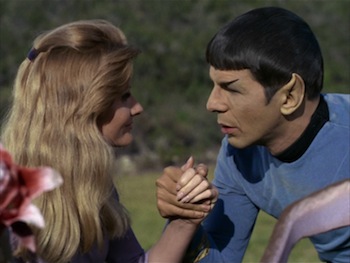“This Side of Paradise”
Written by Nathan Butler and D.C. Fontana
Directed by Ralph Senensky
Season 1, Episode 25
Production episode 6149-25
Original air date: March 2, 1967
Stardate: 3417.3
Captain’s log. The Enterprise arrives at the colony on Omicron Ceti III. The planet is bathed in Berthold rays, a form of radiation that is new to the Federation, so they don’t know its full effects, but extended exposure disintegrates living tissue. It is unlikely that there are any survivors of the colony—led by Elias Sandoval—a likelihood that is increased by the complete lack of response to Uhura’s hails.
However, Kirk beams down a landing party—Spock assures him that limited exposure is safe—including himself, Spock, McCoy, Sulu, DeSalle, and Kelowitz. The settlement is intact, but there’s no sign of any habitation. Kirk waxes rhapsodic on the tragedy of these people travelling all this way, including a year in space to reach the planet, only to die.
And then three people from the colony, including Sandoval, show up alive and well, and doesn’t Kirk feel foolish? Sandoval thinks they came because their subspace radio is on the fritz.
Spock is confused, as Berthold rays are incontrovertibly deadly. McCoy sardonically says that it’s just an educated guess, pure speculation on his part, but his medical opinion is that Sandoval is alive.
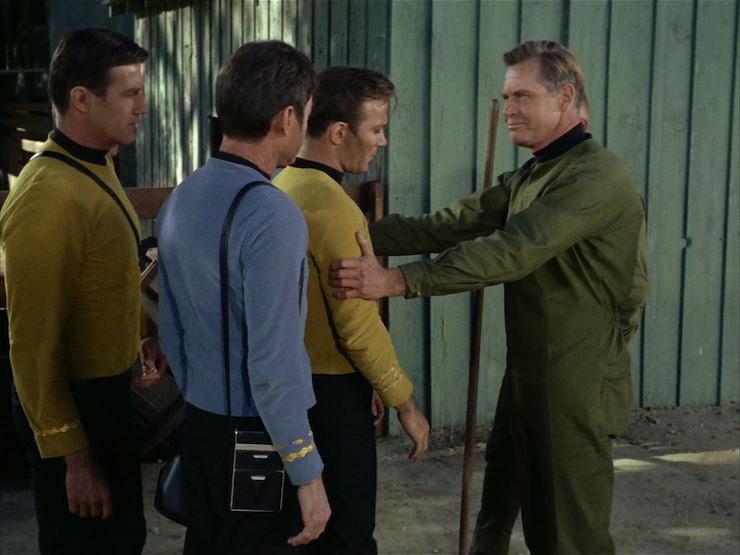
Sandoval leads the landing party to a big house, where they meet Leila Kalomi, their botanist. She and Spock are already acquainted, based on the dewey-eyed look she gives him and the fact that the camera on her is in soft focus (or is slathered in vaseline, it’s hard to tell the difference). Spock, of course, just stares at her impassively. Sandoval is more than happy to let Kirk and the party examine the colony and its people—they have very few mechanical things, no weapons, just a very basic back-to-nature agricultural colony.
Sulu and Kelowitz wander about looking for anything out of the ordinary. Sulu dryly comments that given that what he doesn’t know about farming is a lot, he wouldn’t know out of the ordinary if it was two feet away. However, even he realizes that it’s unusual for there to be no animals whatsoever on a farming colony—no cows, pigs, horses, dogs, nothing.
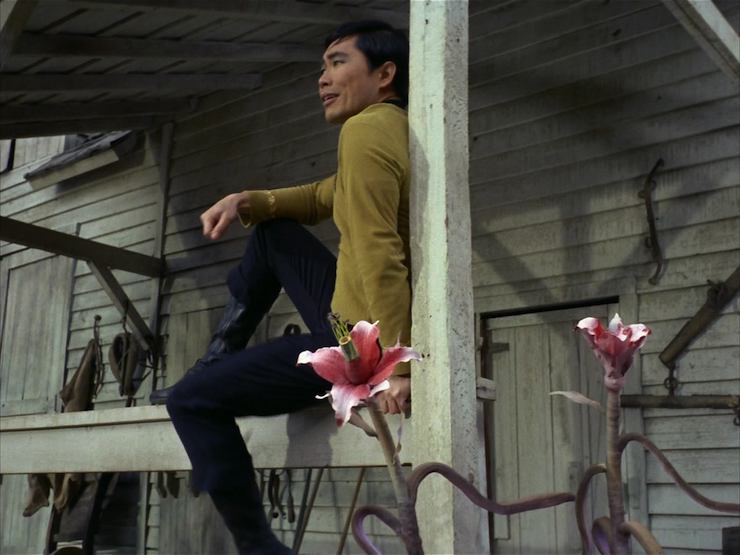
Kalomi tells Sandoval that she met Spock six years ago. He asks if she wants him to stay and become one of them, and Kalomi smiles and says he will whether he wants to or not. Which isn’t at all ominous…
Spock verifies Sulu’s observation: the only non-plant life on the planet are the colonists, which is distressing, since the colony’s original manifest included a passel of animals. DeSalle reports that, while the soil can grow pretty much anything, the colony isn’t growing that much—barely enough to sustain them, with no surplus for emergencies (or, conceivably, for trade).
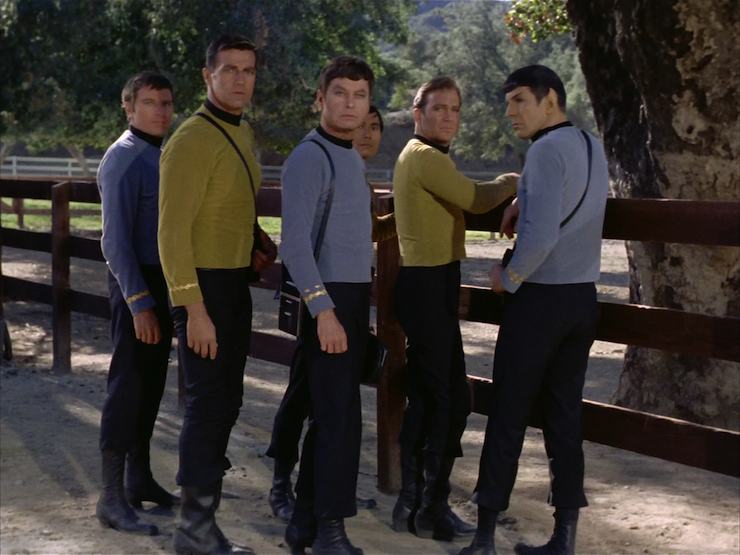
McCoy has the big news, though. His physicals show that all the colonists are in perfect health, across the board, regardless of age. Then he compares his findings with the colony’s medical records—Sandoval has clear lungs and a healthy appendix, but his medical records show scar tissue on his lungs from a childhood ailment and an appendectomy.
Kirk informs Sandoval that he’s under orders to evacuate the colony, but Sandoval refuses to leave. He is also evasive on the subject of the fate of the animals.
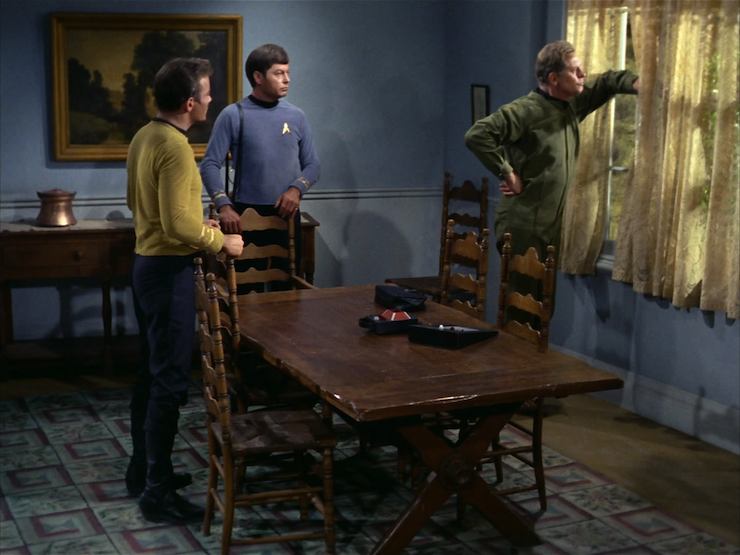
Spock tries to get Kalomi to explain why the planet is so weird, but she only wants to flirt with him. However, she does give in and takes him to a flower, which she says provides peace, love, and happiness. When Spock approaches the hippy-dippy flower in question, he’s showered with spores. He contorts in agony, which surprises Kalomi, as it didn’t hurt anyone else—but after a moment, he’s fine. In fact, he’s better than fine, he’s happy. She says he no longer needs to hide his “inner face” (how she refers to his human half), and he smiles and declares that he loves her.
Kirk orders Sulu to organize landing parties to corral the colonists. He calls Spock, but his first officer has already changed into the pale green overalls favored by the colonists and is lying in the grass with Kalomi admiring the beauty of the clouds. He eventually answers the communicator and disobeys Kirk’s orders to report to him.
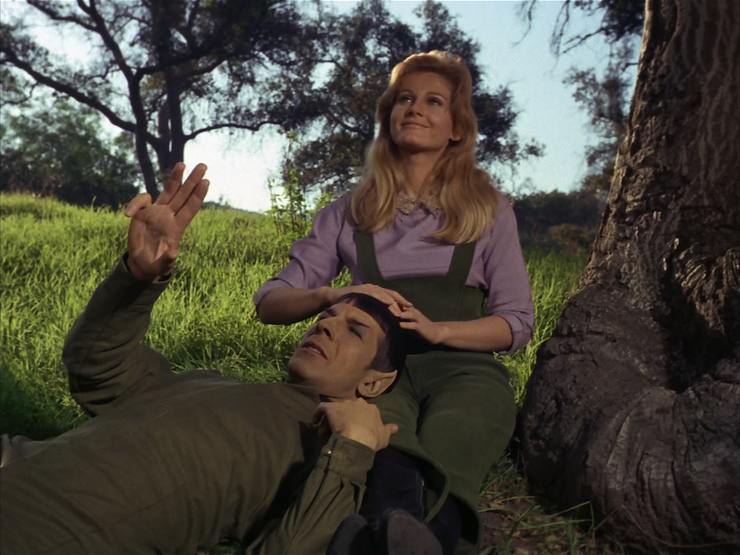
Putting McCoy in charge of the landing parties, Kirk takes Sulu and Kelowitz to find Spock. They track his communicator (which is still open) and they find him hanging from a tree branch and laughing. Angrily, Kirk puts Spock under arrest and into Sulu’s custody until they return to the ship. Spock leads them to some flowers, which spray spores on them. They hit Sulu and Kelowitz, and mostly miss Kirk, who is furious at the fact that Sulu and Kelowitz are now on Spock’s side: they shouldn’t evacuate the colony, it’d be wrong. And hey, look at those rainbows! And have you ever looked at your hand? I mean really looked at your hand?
DeSalle shows McCoy the flowers, and then they beam the flowers to the ship. Kirk angrily beams back up, only to find that Uhura has sabotaged communications except for ship-to-surface. She’s also the only one on the bridge. Kirk stomps down to the transporter room, where there’s a line of crew waiting to beam down. Kirk orders them to return to their stations, and they very calmly refuse. The spores have gotten into the ship’s ventilation system.
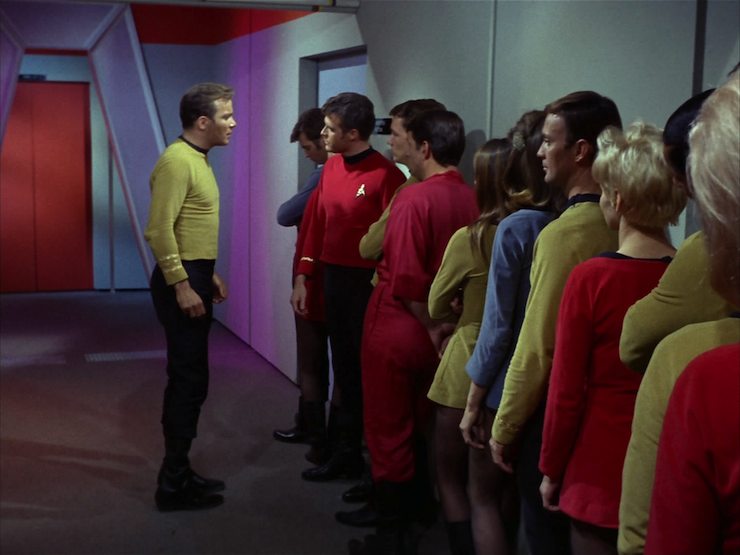
McCoy is too relaxed and happy to try to figure out the physical and psychological effects (which in his case includes talking in an exaggerated drawl). Kirk confronts Sandoval and Spock, who explain that the spores thrive on Berthold rays, and when they inhabit a human host, they provide perfect health and happiness.
Kirk beams back to the ship to find it empty (which raises the question of who beamed him up). He can’t operate the ship alone, so he’s stuck in orbit of the planet. Then he, too, gets hit in the face with the spores, and he contacts Spock, happily saying he’ll beam down after he packs a few things. But seeing his military decorations affects him, and eventually he gets angry again, declaring to the empty transporter room that he can’t leave.
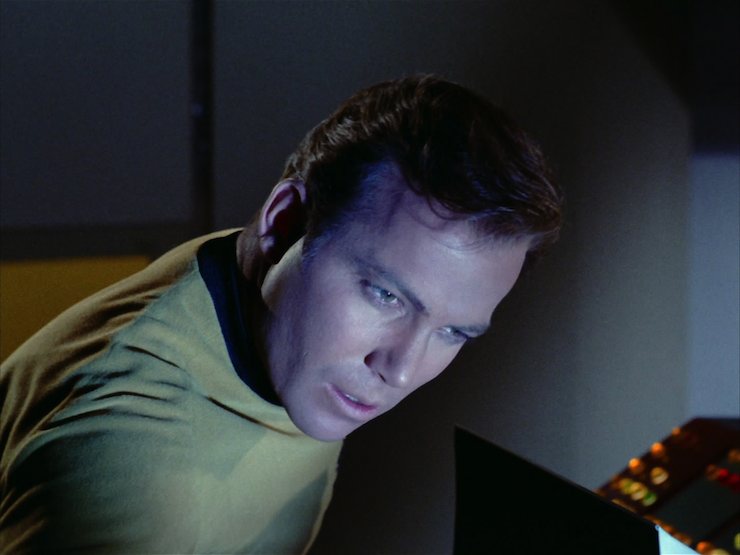
And then he figures it out: the spores make you happy, and they’re neutralized by anger. He convinces Spock to beam up to take care of some things, as the ship will be abandoned once he beams down. When Spock materializes on the transporter platform, Kirk—wielding a pipe—turns into an eight-year-old bully in a schoolyard, calling Spock all kinds of awful names, making fun of Vulcans, then saying Kalomi doesn’t deserve someone who belongs in a circus, not a starship.
Eventually, Spock loses it and beats the shit out of Kirk (trashing the transporter room in the process), and eventually is himself again. However, Spock points out the fallacy of trying to engage 500 crew members and colonists in a brawl. Kirk suggests something a bit more high-tech: a subsonic pulse transmitted through the communications system.
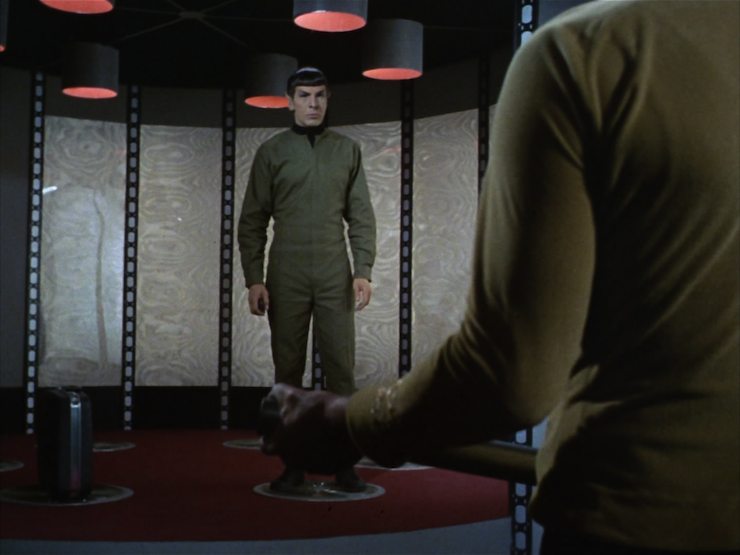
Kalomi is worried about how long Spock is taking, so McCoy calls the ship for her, and she asks to beam up. Spock accedes to her request, and she is devastated to see that he’s back to his old, unemotional self. She begs him to come back with her, as she can’t bear to lose him again, but he refuses—it’s also obvious that it pains him to do so. (She also keeps calling him “Mr. Spock,” which is kind of hilarious.) Her sadness kills the spores in her the same way anger did it for Kirk and Spock.
They set up their pulse, and suddenly tempers flare on the planet. Sulu and DeSalle get into a brawl, as do Sandoval and McCoy. The latter two become clear of the spores, and Sandoval is devastated to realize that his colony has accomplished nothing in three years.
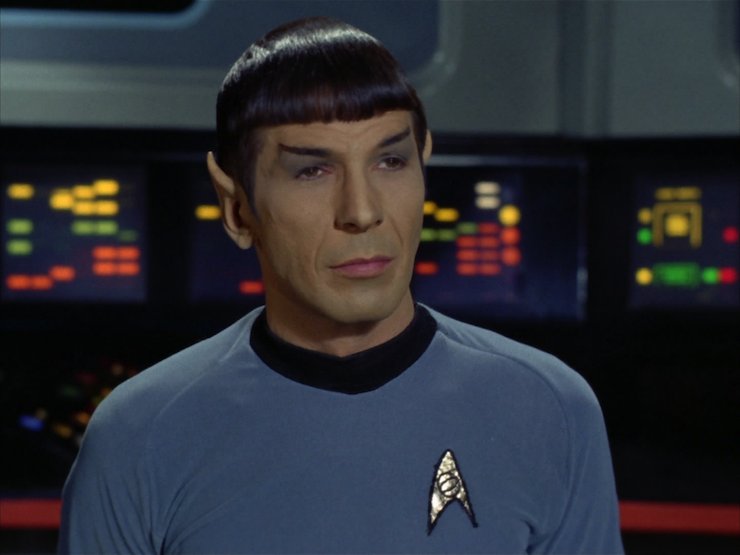
The crew and the colonists are all beamed up, and McCoy reports that they’re still in perfect health—a nice side benefit. Spock laments that this was the first time he was happy.
Can’t we just reverse the polarity? The spores absorb Berthold rays and make you incredibly happy. They also restore their hosts to perfect health, making you wonder why they weren’t used for medicinal purposes going forward.
Fascinating. We get more sexist Spock! “I’ve never understood the female capacity to avoid a direct answer to any question.”
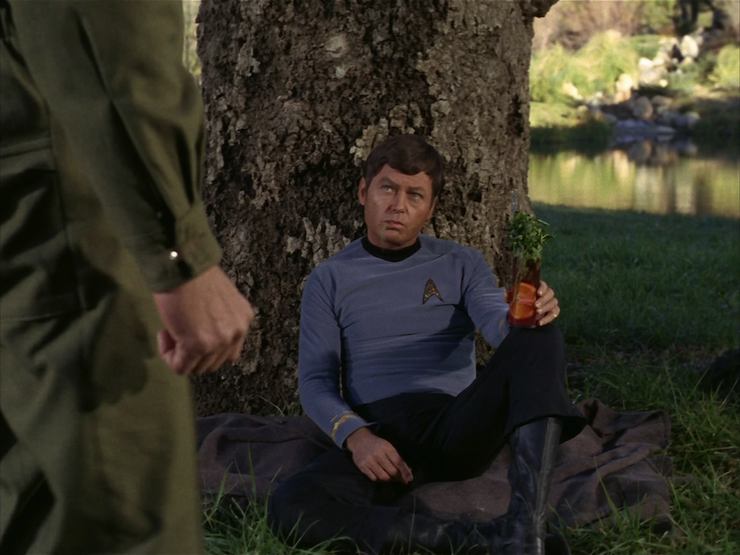
I’m a doctor not an escalator. McCoy talks in an exaggerated Southern accent (and also totally misuses “y’all”) when he’s affected by the spores. We also learn of his fondness for mint juleps.
Ahead warp one, aye. After meeting Sandoval, Sulu asks if he really is alive, proving that he apparently believes in zombies. Or perhaps vampires.
I cannot change the laws of physics! James Doohan doesn’t appear in this episode, but Scotty’s presence is acknowledged when Kirk tries to contact him in engineering.
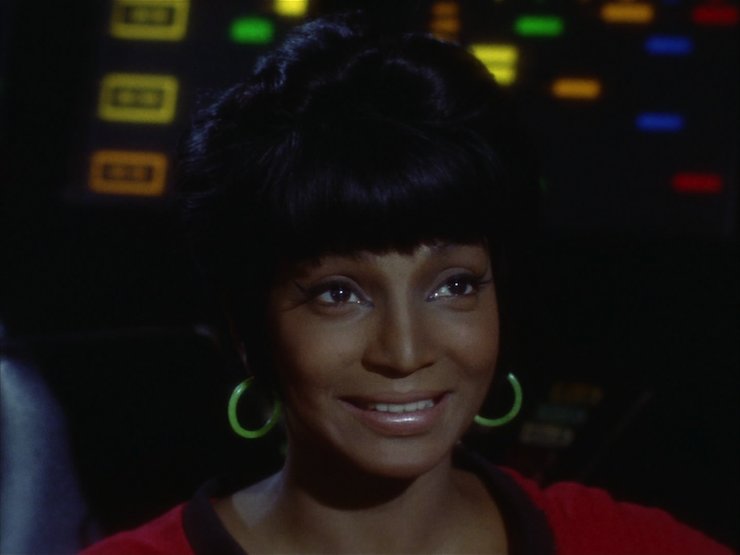
Hailing frequencies open. Under the influence of the spores, Uhura sabotages communications very effectively—and with a sweet smile!
No sex, please, we’re Starfleet. Once he’s been be-spored, Spock changes into civvies and lays on the grass, head in Kalomi’s lap, and picking out animals in the cloud formations. (The only thing missing was Charlie Brown saying he saw a duckie and a horsie. Or, perhaps, Data saying it’s obviously a bunny rabbit…)
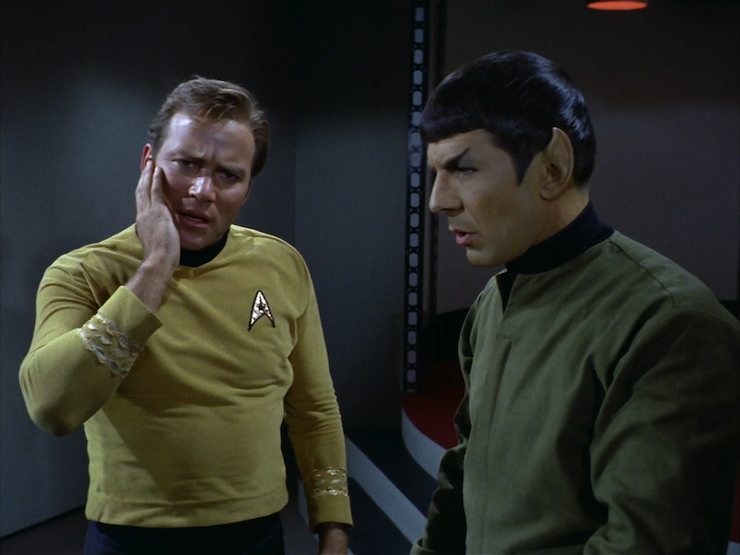
Channel open. “It isn’t every first officer who gets to belt his captain—several times.”
Kirk to Spock after the latter snaps out of it, the former rubbing his aching jaw and holding his aching shoulder as he speaks.
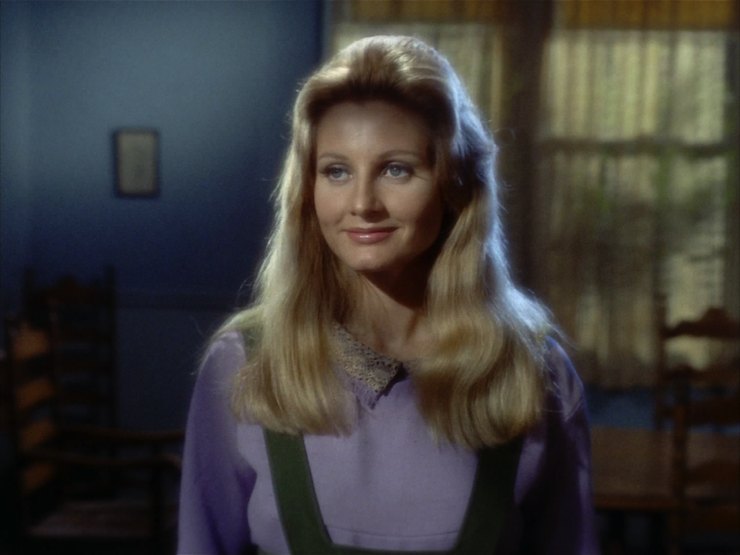
Welcome aboard. Jill Ireland is radiant as Kalomi, while Sandoval winds up being Frank Overton’s final role, as the actor died shortly after filming. Grant Woods makes his third and final speaking appearance as Kelowitz (following “The Galileo Seven” and “Arena“), and the Enterprise crew is filled out by Dick Scotter as Painter (the latest member of the navigator derby), plus recurring regulars Michael Barrier (DeSalle), Eddie Paskey (Leslie), and the usual suspects DeForest Kelley, George Takei, and Nichelle Nichols.
Trivial matters: Nathan Butler was a pseudonym for Jerry Sohl, whose script was heavily rewritten by D.C. Fontana at Gene Roddenberry’s request. In fact, Roddenberry allegedly told Fontana that if she could fix this script, he’d make her story editor, which he later did. Sohl’s original draft had Sulu as the focus.
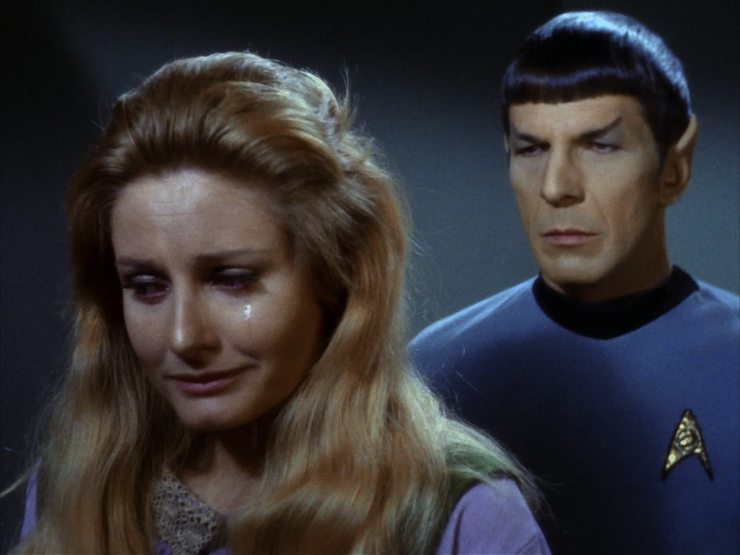
Sohl’s script called for Kalomi to be Eurasian and from Hawaii. So, naturally, they cast her with a blond-haired, blue-eyed Brit…
This episode has the first mention of Admiral Komack, who will eventually be seen in “Amok Time.”
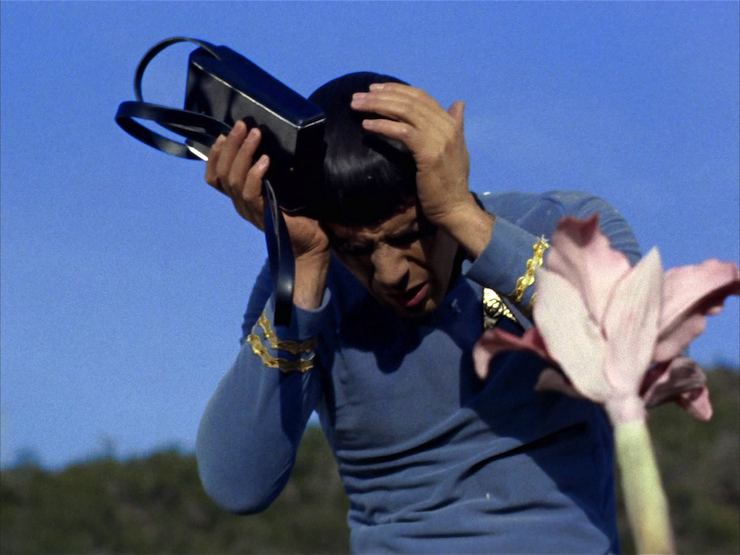
Spock mentions that his mother is a teacher and his father is an ambassador, the first time his parents’ occupations have been stated. We’ll meet his parents in “Journey to Babel,” also written by Fontana, when his father, Ambassador Sarek, comes on board for a diplomatic mission. Spock also reveals that he has another name besides “Spock,” but it’s unpronounceable by humans. Fans and tie-in writers have spent the last five decades coming up with possible names, sometimes to hilarious effect.
The shot of the empty bridge before Kirk walks onto it was used as the blue-screen background for the holodeck re-creation of the Enterprise bridge in the TNG episode “Relics.”
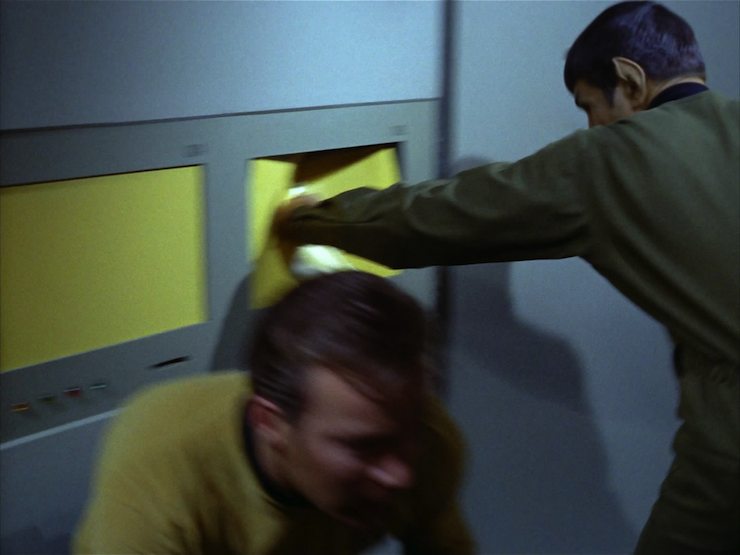
Spock will tell Chekov in “The Tholian Web” that there has never been a mutiny on a starship, which conveniently forgets the mutiny in this very episode.
Berengaria VII (and its dragons) will also be mentioned on the Enterprise episode “Bound,” where the titular ship was investigating putting a starbase on that world. The novel Beneath the Raptor’s Wing by Michael A. Martin establishes that such a starbase was constructed there, and battles occurred there during the Romulan War.
Kalomi’s first meeting with Spock is chronicled in the novel Inception by S.D. Perry & Britta Dennison, which involves not just her and Spock, but also Kirk and Carol Marcus (from The Wrath of Khan). In addition, a poem written by Spock to Kalomi (written by Shirley Meech) called “Sonnet from the Vulcan: Omicron Ceti Three” was published in the 1976 anthology The New Voyages.
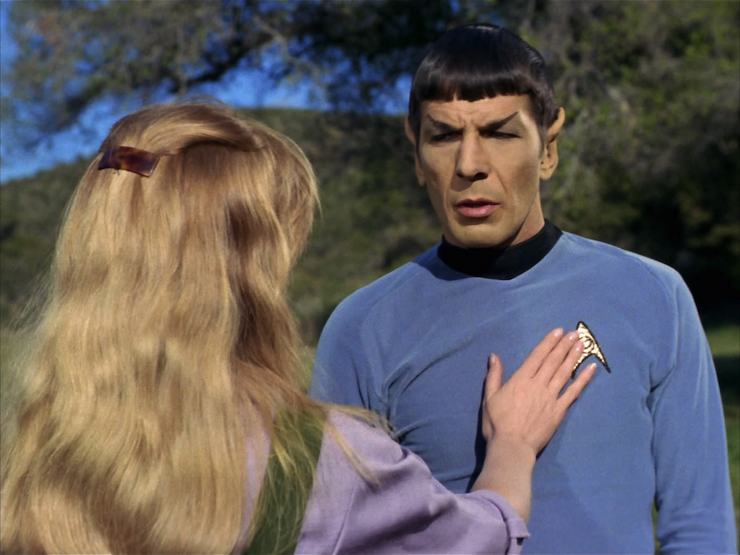
To boldly go. “You’re an overgrown jackrabbit—an elf with a hyperactive thyroid!” This is one of the finest vehicles for Leonard Nimoy the show had provided to this point. The tragedy of Spock’s existence—desperately wanting to be Vulcan, yet with these human emotions just roiling around being suppressed—is on full display here, and Nimoy plays it beautifully. What I particularly admire is the differences among his three sets of interactions with Kalomi. Initially, he’s his usual glacial self, staring blandly at her in the house even as she makes puppy-dog eyes at him while in soft focus. She barely even seems to register on his consciousness as anything other than just another person, and even later in the conversation leading up to her taking him to the spores, his tone with her is no different than it would be with anyone else.
Then, of course, the spores hit, and you gotta think that Nimoy was relieved to actually be able to cut loose while the camera was rolling. The visual of him dangling from a tree branch with a big-ass grin on his face is just magnificent, and so totally alien to what we know of Spock. Even his quick grin in “The Cage“/”The Menagerie” wasn’t as broad and gleeful as the one he mugs with here. He’s completely smitten with Kalomi.
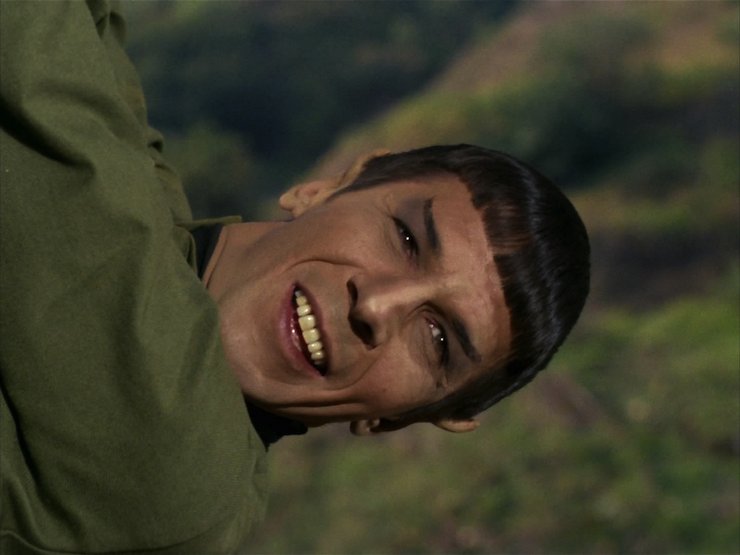
The tour de force, though, is after Kirk snaps him out of it. It would’ve been easy for Nimoy to just revert back to the restrained Spock, but he brings more to it than that. From the moment he stops himself from smashing Kirk in the face with a stool until the episode’s end, there’s a tinge of pain and longing in Nimoy’s tone. It’s obvious in his transporter-room conversation with Kalomi, but we hear it elsewhere when he talks to Kirk. He’s had something wonderful ripped away from him.
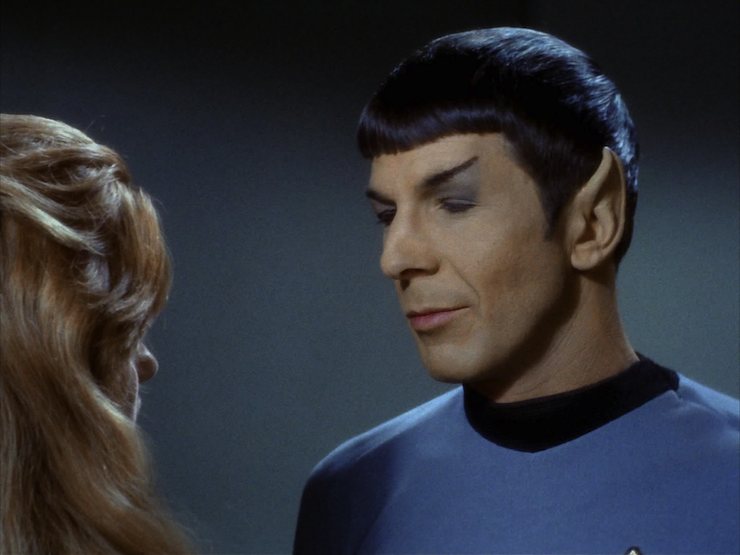
As you watch the episode, it’s easy to think, “Damn, just let them have fun,” but the transformation is too quick—and too mindless. Yes, Spock is experiencing joy, but he’s also not really Spock anymore. Kalomi was in no shape to realize this, being be-spored herself, but while it’s true that Spock could now say “I love you” to her, the things about him that she fell in love with aren’t there anymore. (Well, unless her interest in Spock is purely related to her having a fetish for upswept eyebrows, pointed ears, and bowl cuts…) Although as weird as Spock’s transformation is, McCoy’s is even scarier—not only is that Southern accent awful, but the notion of the good doctor without any curmudgeonliness in him doesn’t bear thinking about…
Warp factor rating: 7
Next week: “The Devil in the Dark”
Keith R.A. DeCandido will be a guest at Dragon Con 2015 over this upcoming Labor Day weekend, where he’ll be doing a reading, an autographing, a practical self-defense workshop, and flipping great wodges of panels. Here’s his full schedule.










